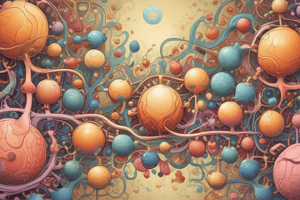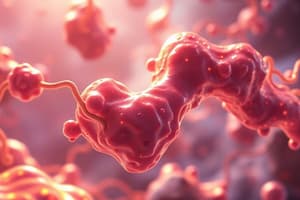Podcast
Questions and Answers
Which of the following best describes the primary role of hormone-sensitive lipase (HSL)?
Which of the following best describes the primary role of hormone-sensitive lipase (HSL)?
- Promoting the synthesis of triglycerides.
- Mobilizing stored triglycerides into glycerol and free fatty acids. (correct)
- Inhibiting the breakdown of lipids to increase storage.
- Facilitating the storage of fatty acids in adipose tissue.
What is the primary significance of bile acids in lipid metabolism?
What is the primary significance of bile acids in lipid metabolism?
- They aid in the digestion and absorption of lipids through emulsification. (correct)
- They directly synthesize cholesterol in the liver.
- They facilitate the absorption of dietary cholesterol directly into the bloodstream.
- They regulate the expression of genes involved in cholesterol synthesis.
How does insulin primarily influence lipid metabolism?
How does insulin primarily influence lipid metabolism?
- By having no effect on lipid synthesis and lipolysis.
- By inhibiting both lipid synthesis and lipolysis.
- By promoting lipid synthesis and inhibiting lipolysis. (correct)
- By promoting lipolysis and inhibiting lipid synthesis.
During prolonged fasting, which tissue predominantly utilizes ketone bodies for energy?
During prolonged fasting, which tissue predominantly utilizes ketone bodies for energy?
Which of the following is a key characteristic of dyslipidemia?
Which of the following is a key characteristic of dyslipidemia?
What is the primary role of bile salts in lipid digestion?
What is the primary role of bile salts in lipid digestion?
Which cellular organelle is the primary site of fatty acid oxidation?
Which cellular organelle is the primary site of fatty acid oxidation?
During a fasting state, which of these would the liver primarily produce to serve as an alternative source of energy for tissues, including the brain?
During a fasting state, which of these would the liver primarily produce to serve as an alternative source of energy for tissues, including the brain?
What two-carbon molecule serves as the precursor for fatty acid synthesis?
What two-carbon molecule serves as the precursor for fatty acid synthesis?
Which lipoprotein is primarily responsible for transporting dietary triglycerides from the intestines to other tissues?
Which lipoprotein is primarily responsible for transporting dietary triglycerides from the intestines to other tissues?
What is the main purpose of high-density lipoproteins (HDL) in lipid metabolism?
What is the main purpose of high-density lipoproteins (HDL) in lipid metabolism?
Which process involves the sequential removal of two-carbon units from fatty acids, resulting in the production of acetyl-CoA?
Which process involves the sequential removal of two-carbon units from fatty acids, resulting in the production of acetyl-CoA?
Which of the following is NOT a direct product of triglyceride hydrolysis by lipases in the small intestine?
Which of the following is NOT a direct product of triglyceride hydrolysis by lipases in the small intestine?
Flashcards
What are lipids?
What are lipids?
A diverse group of hydrophobic molecules, including fats, oils, phospholipids, and steroids. They are essential for energy storage, membrane structure, and hormone production.
What is lipid metabolism?
What is lipid metabolism?
The metabolic processes involved in the synthesis (building) and breakdown (breaking down) of lipids.
How are lipids digested and absorbed?
How are lipids digested and absorbed?
Enzymes, primarily lipase, break down dietary triglycerides (fats) into fatty acids and glycerol in the small intestine. Bile salts emulsify lipids to increase their surface area for digestion.
What is fatty acid oxidation?
What is fatty acid oxidation?
Signup and view all the flashcards
What are ketone bodies?
What are ketone bodies?
Signup and view all the flashcards
How are lipids synthesized?
How are lipids synthesized?
Signup and view all the flashcards
What are lipoproteins?
What are lipoproteins?
Signup and view all the flashcards
What are chylomicrons?
What are chylomicrons?
Signup and view all the flashcards
What is cholesterol?
What is cholesterol?
Signup and view all the flashcards
What does insulin do to lipid metabolism?
What does insulin do to lipid metabolism?
Signup and view all the flashcards
What's the liver's role in lipid metabolism?
What's the liver's role in lipid metabolism?
Signup and view all the flashcards
What is dyslipidemia?
What is dyslipidemia?
Signup and view all the flashcards
What are bile acids?
What are bile acids?
Signup and view all the flashcards
Study Notes
Lipid Metabolism Overview
- Lipids are a diverse group of hydrophobic molecules, including fats, oils, phospholipids, and steroids.
- Lipid metabolism encompasses the processes involved in the synthesis and breakdown of these molecules.
- These processes are crucial for energy storage, membrane structure, and hormone production.
- Lipid metabolism is tightly regulated to maintain homeostasis.
Lipid Digestion and Absorption
- Dietary lipids, primarily triglycerides, are broken down in the small intestine.
- Lipase enzymes, secreted by the pancreas, hydrolyze triglycerides into fatty acids and glycerol.
- Bile salts emulsify lipids, increasing their surface area for enzymatic action.
- Fatty acids and glycerol are absorbed into intestinal cells and re-esterified into triglycerides.
- Chylomicrons, lipoprotein particles, transport triglycerides to various tissues.
Fatty Acid Oxidation (Beta-Oxidation)
- Fatty acids are the primary fuel source during periods of prolonged fasting or exercise.
- Fatty acid oxidation occurs in the mitochondria.
- The process involves a four-step cycle: oxidation, hydration, oxidation, and thiolysis.
- Each cycle shortens the fatty acid chain by two carbons, releasing acetyl-CoA.
- Acetyl-CoA enters the citric acid cycle (Krebs cycle) to generate ATP.
Ketone Body Formation
- During prolonged fasting or starvation, when glucose is scarce, the liver produces ketone bodies.
- Acetoacetate, beta-hydroxybutyrate, and acetone are the main ketone bodies.
- Ketone bodies are transported to peripheral tissues as an alternative energy source.
- Ketone bodies are particularly important for brain function when glucose is limited.
Lipid Synthesis
- Lipid synthesis occurs primarily in the liver.
- Acetyl-CoA is the precursor for fatty acid synthesis.
- Fatty acid synthesis involves a repeating series of reactions, including the addition of two-carbon units.
- Enzymes involved in fatty acid synthesis are different from those involved in fatty acid oxidation.
Lipoprotein Metabolism
- Lipoproteins are spherical complexes that transport lipids in the blood.
- Chylomicrons transport dietary triglycerides.
- Very-low-density lipoproteins (VLDL) transport endogenous triglycerides.
- Low-density lipoproteins (LDL) transport cholesterol to tissues.
- High-density lipoproteins (HDL) remove excess cholesterol from tissues and transport it to the liver for excretion.
Cholesterol Metabolism
- Cholesterol is essential for membrane structure and steroid hormone synthesis.
- Cholesterol synthesis occurs in the liver.
- Cholesterol can be obtained from the diet or synthesized in the body.
- Bile acids are derived from cholesterol and aid in lipid digestion.
- Excess cholesterol can potentially contribute to cardiovascular disease.
Regulation of Lipid Metabolism
- Hormone-sensitive lipase (HSL) plays a crucial role in mobilizing stored triglycerides.
- Insulin promotes lipid synthesis and inhibits lipolysis.
- Glucagon and epinephrine promote lipolysis and inhibit lipid synthesis.
- Other hormones, such as thyroid hormones, also influence lipid metabolism and regulate fat storage, mobilization, and utilization.
- Various enzymes and regulatory proteins fine-tune the pathway at multiple steps to precisely meet metabolic demands.
Clinical Significance
- Dyslipidemia, characterized by abnormal lipid levels, is a major risk factor for cardiovascular disease.
- Genetic defects in lipid metabolism can lead to various disorders.
- Understanding lipid metabolism is crucial for diagnosing and managing metabolic diseases.
Special Considerations in Lipid Metabolism
- Different tissues specialize in different aspects of lipid metabolism.
- For example, the liver plays a central role in lipid synthesis, disposal, and utilization.
- Muscle tissue is important for fatty acid oxidation as an energy source.
- Brain utilizes ketone bodies during prolonged fasting.
Studying That Suits You
Use AI to generate personalized quizzes and flashcards to suit your learning preferences.




